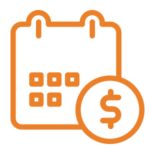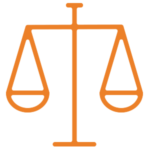Repaying your Student Loans
Successfully repaying your student loans is important. It can be easier and less costly when you’re more informed. Browse the information below for a greater understanding of terminology and the options available to you as a student loan borrower.
Can I make online payments?
Usually. If your loan is not in default, contact your lender to discuss payment channels they have available to you.
If your loan is in default and held by Trellis, you may use our online account management tool, myTrellis, to make online payments. You can also make payments on your phone with the myTrellis Payment App (available for Android and iOS). You can download the app via Google Play or Apple App Store. You will need to create a user account. Payment methods include automatic draft (autodraft) from a checking or savings account at no cost to you. Debit card and credit card payments are also accepted online with a processing fee assessed by our 3rd party payment processor. For more information, contact Trellis Borrower Services at (800) 222-6297 or borrowerservices@trelliscompany.org.
Can I make payments directly on my phone?
Yes. If your loan is in default and held by Trellis, you can download the myTrellis Payment App for Android and iOS mobile devices. Please note: New users will need to register.
The myTrellis Payment App provides a quick, secure, and mobile-friendly way for our account holders to make a payment on their account, manage payments and account information, and stay up to date on balances.
My loan balance appears to be incorrect.
If your loan balance doesn’t reflect all of your payments, or if you believe that you’ve paid your loan in full, request a statement of your account from Trellis Borrower Services at (800) 222-6297 or borrowerservices@trelliscompany.org. After reviewing the information, if you continue to disagree with the balance on record, send two copies of cancelled checks, money orders, or other pertinent information to support any payments not reflected on the statement to Trellis Borrower Services via email or postal mail at Trellis Borrower Services, P.O. Box 83100, Round Rock, TX, 78683-3100.
If your balance does not reflect the federal income tax refund offset about which you were notified, send a copy of your tax refund offset notice to Trellis Borrower Services.
My loan should not be in default.
If you feel that your loan should not be in default, you must provide documentation that shows that your loan was erroneously placed in default even though you took timely and appropriate actions, such as submitting appropriate deferment forms.
Ask your lender directly about what documentation you need to provide to determine whether your situation warrants reconsideration of its default status.
I received no lender contact prior to default.
Borrowers are required to make payments on student loans even if they don’t receive a bill or a repayment notice. Even though they’re not obligated to do so, many lenders send billing statements to borrowers as a convenience. However, not receiving a notice doesn’t remove your obligation to make regular payments. Sometimes a borrower may not receive a billing statement from the lender because the borrower failed to notify the servicing agency about address changes.
If you believe that your lender should reconsider placing you in default, contact your lender directly.
I was not of a legal age to obtain the student loan (infancy).
Borrowers cannot remove the obligation to repay student loans based on the fact that they were not old enough to take out the loans when they did so. By virtue of Section 484A(b)(2) of the Higher Education Act of 1965 (20 U.S.C. 1091a(b)(2)), the argument that “the signing of a contract by a minor does not create a binding obligation” can no longer release you from your obligation to repay your student loan.
I am unable to pay.
If your loan is not in default, you may qualify for a loan deferment, forbearance, or Income-Based Repayment (IBR). Contact your lender for more information and eligibility requirements.
If your loan is in default and you cannot afford to make payments, contact Trellis Borrower Services to discuss available options. In some cases, you may qualify for lower payment amounts based on your current financial situation provided you can provide evidence of your inability to pay (i.e., paycheck stub, copies of billing statements). Contact Trellis Borrower Services at (800) 222-6297 or borrowerservices@trelliscompany.org.
I am an incarcerated borrower.
If your loan is not in default, you, or someone on your behalf, should notify the agency servicing the loan of the location and terms of incarceration.
If your loan is in default, Trellis Borrower Services can provide current reporting procedures for individual circumstances — contact Trellis Borrower Services at (800) 222-6297 or borrowerservices@trelliscompany.org.
The school did not provide the education for which I paid.
Borrowers who are dissatisfied with the quality of the educational services they received sometimes raise this as a defense or objection to repaying a student loan. However, your enrollment agreement with your school is separate and distinct from a loan contract with a lender. Even if you have a claim against the school, you must still honor your loan contract with the lender.
Borrowers who have claims against Texas schools should present those claims against the school directly to the Texas Workforce Commission. Students who have complaints against cosmetology schools in Texas should contact the Texas Department of Licensing and Regulation Cosmetology Program.
In some instances, complaints against a school may be valid grounds for reducing or canceling an obligation to repay a student loan. For example, the loan liability of borrowers who prove they withdrew from enrollment and were owed, but never received, a refund of tuition and fees may be able to have their loans reduced.
The school closed before I completed my program of study.
The US Department of Education has formulated guidelines for the cancellation of student loan debt in instances where the school closes before a student completes a program of study. Visit StudentAid.gov to obtain a Closed School Application to determine whether you qualify for cancellation of any part of your student loan.
The school I attended won’t release my transcript.
If your school won’t release your academic transcript unless your defaulted loan is satisfied, keep working with the school. The academic transcript is the property of the school, and the school is responsible for deciding whether to release the transcript. No federal law exists to allow a guaranty agency to require a school to either release or not release an academic transcript. Trellis can only inform schools of the current status of student loan accounts.
The statute of limitations has run out on this debt.
Regardless of the age of the debt, statutes of limitations are not valid defenses against repayment of a student loan. By virtue of section 484A(a) of the Higher Education Act, no statute of limitations limits the Department of Education’s or a guaranty agency’s ability to file suit, enforce judgments, initiate offsets, or take other actions to collect a defaulted student loan.
How do I remove a defaulted loan from my credit reports?
Trellis makes periodic updates to federal credit reporting agencies; however, negative credit information may be reported for up to seven years. In other words, whether your loan is paid off following a default or not, the fact that you at one time had a defaulted loan may cause it to remain on your credit report for some time.
It is possible to have the defaulted student loan information removed from your credit report through the federal loan rehabilitation program. For more information on loan rehabilitation and the eligibility requirements contact Trellis Borrower Services at (800) 222-6297 or borrowerservices@trelliscompany.org.
What can I do about having multiple student loans at different agencies?
Loan consolidation is a good way of combining federal student loans that are owed to multiple agencies, thus easing your repayment and communication challenges. The money you receive from a consolidation loan is used to pay off your existing student loan debt. Loan consolidation offers an affordable way to repay your student loan debts and remove them from default. Depending on the types of loans you have, after consolidation you may be able to make one monthly payment.
There are restrictions on the types of loans that can be consolidated, and some borrowers won’t benefit from consolidation. Contact your loan holder to find out whether you’re eligible to use loan consolidation to improve your situation, and whether consolidation would be a good idea for you.
I am a US disabled veteran. Can I have my student loan canceled?
Federal regulations provide for the cancellation of student loans if the borrower becomes totally and permanently disabled (TPD). You must contact Nelnet, the U.S. Department of Education’s TPD servicer, to advise them of your intent to request a total and permanent disability discharge. Contact Nelnet online at www.disabilitydischarge.com, by phone at (888) 303-7818, or by email at disabilityinformation@nelnet.net.
I need additional financial aid to go back to school, but I am in default on a student loan.
The Department of Education has made provisions that allow defaulted borrowers to regain eligibility for additional Title IV financial assistance. This renewed eligibility can be granted only once to a borrower who meets the qualifications. Currently, if you enter repayment with Trellis and make six consecutive on-time monthly payments, you may become eligible for Title IV reinstatement. You must continue to make these monthly payments to retain the renewed eligibility. Contact Trellis Borrower Services at (800) 222-6297 or borrowerservices@trelliscompany.org to request that your account be tracked for Title IV reinstatement.
How do I qualify for a loan discharge?
The Department of Education’s website provides a FAQ on loan forgiveness, cancellation, and discharge.
How much do I owe?
The National Student Loan Data System (NSLDS) Student Access portal can tell you. Log in with your Federal Student Aid (FSA) ID.
How can I start the repayment process if I don’t hear from my lender?
Although your loan servicer will generally notify you of the date your first payment will be due, you can get in touch with the lender through the contact information on your Master Promissory Note. You should do this if you think it’s past time you heard from your loan holder, and especially if you’ve recently changed your address.
When do I have to start repaying my student loans?
Repayment requirements differ depending on the type of loan in question.
Direct Subsidized and Direct Unsubsidized: You don’t have to begin repaying Direct Subsidized and Direct Unsubsidized federal student loans until after you leave college or drop below half-time enrollment. Once either of those things happens, the clock starts on a six-month grace period during which you’re assumed to be getting financially settled. Repayment begins the day after the grace period ends — that’s when interest on the loan begins to accrue. Your first payment is due within 60 days after the end of the grace period. By default you’ll go into a Standard Repayment Plan.
Student PLUS: Repayment begins as soon as you receive the final disbursement of the loan. However, your loan will be placed into deferment while you’re enrolled at least half time and during the six months after you leave school, with your first payment due no more than 60 days later.
Parent PLUS: As with Student PLUS loans, repayment begins upon final disbursement of the loan. Generally, your first payment is due within 60 days of the final disbursement, unless you choose to delay making payments while your dependent student is enrolled in school at least half time.
What options do I have in repayment plans?
If you don’t act, you’ll begin repaying your loans under the Standard Repayment Plan, but borrowers have other options. The US Department of Education (ED) provides an overview table of federal loan repayment plans, and it offers a Repayment Estimator that can help you figure out which repayment plan is best for you. If you log in with your Federal Student Aid (FSA) ID, this tool will provide a comparison of estimated monthly payment amounts for all federal student loan repayment plans to help you visualize the difference in repayment terms, interest accrued, and total amount paid. Consider all of these factors when choosing a repayment plan that’s right for your particular financial situation, but keep in mind that not all loan types are eligible for all repayment plans. ED has also developed a fact sheet that provides more information about the various income-driven repayment plans.
Here are some key facts about repayment plan options: https://studentaid.gov/manage-loans/repayment/servicers
How can I take advantage of one of these repayment plans?
Contact your loan servicer.
Is there such a thing as loan forgiveness?
Two federal loan forgiveness programs are available to individuals who enter public service careers. Under the Teacher Loan Forgiveness Program (TLFP), Federal Stafford and Federal Direct loan borrowers who teach for five consecutive, complete years at an eligible school may qualify to have some of their loan balances forgiven. Through the Public Service Loan Forgiveness Program (PSLFP), borrowers may qualify for forgiveness of the remaining balance due on their eligible Federal Direct loans after they have made 120 monthly payments on those loans under an eligible repayment plan while employed full time in eligible public service occupations.
Are there any other options for getting my loans discharged?
The federal student aid programs provide for discharge of certain types of federal student loans if you become totally and permanently disabled.
Should I consider loan consolidation?
By consolidating your loans you might be able to reduce your monthly payments in the short term, though you may wind up paying more in total over your repayment period. Your loan holder or servicer can help you determine whether you’re eligible and whether loan consolidation is the best option for you.
What is deferment?
Deferment is a tool available to borrowers to help them meet their loan repayment obligations. Once the repayment period has begun, you’re entitled to defer your student loan payments if you meet certain criteria. Through deferment, you can postpone your scheduled student loan payments for various reasons, such as unemployment, economic hardship, and school enrollment. Your lender or servicer determines whether you meet the requirements for a deferment based on documentation that you submit.
During a deferment period, you’re not responsible for paying the interest that accrues on a subsidized Stafford or Direct loan, or any portion of a Consolidation loan eligible for federal interest benefits. However, you’re responsible for paying the interest that accrues on unsubsidized Stafford, Direct, PLUS, and Grad PLUS loans, as well as unsubsidized portions of a Consolidation loan. If you fail to make required interest payments during a deferment period, the loan holder or servicer may capitalize the unpaid accrued interest. To ensure prompt processing of your deferment, please complete a deferment application and forward directly to your loan holder or servicer.
What is forbearance?
Forbearance is a period of time during which a lender permits a borrower to temporarily postpone making payments or make reduced payments. Medical or financial problems that don’t meet the requirements for a deferment may qualify you for forbearance.
During a forbearance period, you’re responsible for paying the interest that accrues on any loan, including a subsidized Stafford or Direct loan. If you fail to make required interest payments during a forbearance period, the lender or servicer may capitalize the unpaid accrued interest.
A loan holder or servicer may grant a general forbearance to assist you in fulfilling the repayment obligations of the loan and help prevent default. The loan holder or servicer must approve the forbearance request before your payments can be suspended.
If your monthly payments are more than your current financial situation will permit, help is available. Please contact your loan holder, servicer, or Trellis Company immediately to learn about your options and avoid the consequences of default.
Here are some answers to frequently asked questions.
I cannot pay my loan. What should I do?
Contact your lender, servicer, or Trellis and explain that you cannot pay and why. Your servicer works with and for your lender to bill, collect, and provide you with information pertinent to your loan. Contact your servicer immediately if you’re having trouble making your loan payments so you can avoid delinquency and potential default. Your lender, servicer, or Trellis may be able to provide you with repayment options and help you through your financial rough spot.
What is Trellis Company?
Trellis Company is a nonprofit organization that has an agreement with the US Department of Education to administer the Federal Family Education Loan Program (FFELP). Trellis Company is a guarantor of your FFELP student loans. One of Trellis’ primary responsibilities is to provide information to help borrowers understand FFELP loans and their obligation to repay those loans.
If a borrower fails to make payments on a loan for at least 270 days, he or she is considered in default. In that case, the lender may file a default claim with Trellis for repayment of the loan. Trellis will pay the money the borrower owes to the lender, and then becomes responsible for collecting the loan on behalf of the federal government.
What does default mean?
Default is the failure to repay a loan according to the terms you agreed to. For most federal student loans, you’ll be in default if you have not made a payment in more than 270 days. After that, your lender can file a default claim with the guarantor of your student loans. The guarantor is responsible for paying the money you owe to your lender. The guarantor then works to collect your loan on behalf of the federal government through a variety of options.
A couple of other terms you may see: “Current” means you’ve kept up with payments on your loan. “Delinquent” means the loan servicer has not received payment by the date it was due.
What does “claim pending” mean?
Claim pending means the guarantor has not yet paid the lender’s claim, and it might be possible for you to avoid the consequences of default. However, once your lender files a claim, the guarantor will pay the claim after only a few days. You must act immediately!
What does it mean when the claim has been paid?
When a default claim is paid, the guarantor takes over the responsibility to collect on your loan on behalf of the federal government.
Because default can have negative consequences, you should attempt to avoid it. For example, after you default, the cost of collecting on your debt may be added to the balance of your loans. Any income tax refunds that you’re eligible to receive may be diverted to repay your defaulted student loans. Money to repay your debt could be deducted directly from your paycheck without your consent. Default also has a negative impact to your credit. Federal regulations require a guarantor to report your defaulted loans to all nationwide consumer reporting agencies. The record of your defaulted student loan will continue to show up on your credit report for seven years from the date of the delinquency that led to the default.
Fortunately, if you see yourself falling behind in your student loan payments, you have a number of options, including deferment, forbearance, loan consolidation, and a variety of repayment plans.
How can I make payments on a loan that’s in default?
If Trellis Company is the holder, several payment methods are available for your defaulted student loan.
Credit card, debit card, or autodraft
Make payments online using Trellis’ account management tool, myTrellis. Trellis does not charge a fee for autodraft payments; however, you should check with your financial institution about any fees it may charge. Our payment processing service provider assesses a processing fee for debit and credit card payments. The total charge (your payment plus the processing fee) is disclosed to you before the transaction is authorized so you may cancel before any charges are incurred.
If you agree to set repayment terms with Trellis, you may take advantage of the recurring autodraft payment service and have your payments automatically deducted each month. Trellis does not charge a fee for recurring autodrafts; however, you should check with your financial institution about any fees it may charge.
Check, money order, or cashier’s check
Mail (US Postal Service)
Trellis Company
P.O. Box 659602
San Antonio, Texas 78265-9602
Overnight delivery
Trellis Company
301 Sundance Pkwy.
Round Rock, Texas 78681
In our lobby during regular business hours (M-F, 8:00 a.m. to 5:00 p.m., Central Time)
301 Sundance Pkwy.
Round Rock, Texas 78681
Please include your Trellis Company account number with your payment to ensure proper crediting. If you don’t know your Trellis account number, call Trellis Borrower Services at (800) 222-6297 or send an email to borrowerservices@trelliscompany.org.
For more information on payment methods, call Trellis Borrower Services at (800) 222-6297 or send an email to borrowerservices@trelliscompany.org.
For non-payment correspondence, please use Trellis’ general correspondence address:
P.O. Box 83100
Round Rock, TX 78683-3100
I’m in default — what options do I have to make my loan current again?
You can enter into our loan rehabilitation program, take advantage of several different repayment terms, or apply for loan consolidation. Benefits of moving your loans out of default include reinstatement of eligibility for federal student aid.
What is a deferment? What deferments are available?
A deferment allows you to postpone payment of your loan. You’re entitled to defer your student loan payments when you meet certain eligibility criteria and you request a deferment. Several deferments are available, covering different financial situations. To apply or get further information about deferments, contact your lender, servicer, or Trellis Company. You can also access and download deferment forms from our website.
What is forbearance?
Forbearance is a period of time during which a lender permits a borrower to temporarily postpone making payments or make reduced payments. Forbearance is usually granted at the discretion of the lender. Borrowers are still responsible for paying the interest that accrues; if unpaid, the interest may be capitalized. Forbearance is often used to bring delinquent loans current in situations where a borrower suffers a legitimate financial hardship but doesn’t qualify for a deferment.
What is interest capitalization?
Capitalization occurs when a lender adds unpaid accrued interest to the outstanding principal balance of a loan, increasing the balance, or the total amount owed. Interest then accrues on the new total principal balance.
I sent my payment (or my deferment or forbearance form) but my lender or servicer didn’t receive it. What should I do? Will my loan default?
If your lender didn’t receive a payment, contact the lender as soon as possible. Tell the representative the amount of your payment, when you mailed it, and the check or money order number. If the payment was a check, ask your bank if and when it cleared. If it did clear, provide this information to the lender along with a copy of the front and back of the check if possible. You might be asked to do the same with a money order. Write legibly on all correspondence and keep copies. Don’t delay — your lender can file a claim with the guarantor if it fails to receive a payment, deferment, or forbearance and your loan becomes at least 270 days delinquent.
If your lender didn’t receive your deferment or forbearance form, contact the lender as soon as possible. Request a copy of the appropriate form and send the completed form to the lender, either by fax or as a scanned email attachment. You can download deferment forms from our website.
I’m in school. Why am I being billed? How can I be delinquent? What can I do?
If you’re in school and being billed for your student loans, you probably transferred schools, dropped below half-time status, or are attending school beyond your anticipated graduation date. You should contact your lender immediately and provide proof of your in-school status. If you fail to do so, your lender will expect you to begin making payments when your grace period ends. You should contact your lender whenever your circumstances change.
My child, a dependent student for whom I took out a loan, is still in school. Why am I being billed? How can I be delinquent? What can I do?
If you took out a Parent PLUS loan for a dependent student who’s still enrolled in school and you’re getting billed for the loan, tell your lender it should defer payments until six months after your student is no longer enrolled at least half time. If your student has transferred schools, or is attending school beyond his or her anticipated graduation date, contact your lender and provide proof of your student’s at least half-time enrollment status. If your student has dropped below half-time enrollment, contact your lender for other options.
You keep calling my relatives — why?
When you signed the promissory note for your loan, you provided the names, addresses, and phone numbers of relatives and friends to be contacted in the event your loan holder, servicer, or loan guarantor is unable to contact you. These parties may get in touch with those contacts to obtain your current address and phone number.
Who handles reports to consumer reporting agencies?
Federal regulations require your lender to report your loan and repayment information to all nationwide consumer reporting agencies. If Trellis Company pays a default claim, federal regulations also require Trellis to report the default.
I just filed for bankruptcy and I’d rather collectors speak with my attorney. What should I do?
Provide your attorney’s name and telephone number to debt collectors when they contact you. The case number, city filed in, date filed, and chapter are also helpful. The more information you can provide, the faster the collection attempts will stop.
Where are my loans?
You can get a complete listing of your loans from the National Student Loan Data System by logging in with your FSA ID.
Trellis Company can track the loans that we’ve guaranteed. Call Trellis Default Aversion at (800) 338-4752 or access your Trellis Company account at myTrellis.
Your financial aid office can help track loans with other guarantors and the Department of Education.
Questions about default prevention? We have answers.
Trellis Company
P.O. Box 83100
Round Rock, TX 78683-3100
Phone: (800) 338-4752
Fax: (512) 336-6566
Email: trellishelps@trelliscompany.org
Monday – Thursday, 8 a.m. – 7 p.m., Friday, 8 a.m. – 5 p.m.
If you need help determining who services your federal loan, please log on to your account at https://studentaid.gov/.





